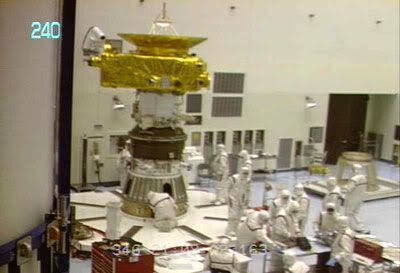
Click here to view the live webcam feed from Cape Canaveral Air
Force Station in Florida ( RealOne Player is required for viewing),
or view the snapshots if your computer does not support RealOne.
New Horizons will be the world's first ever mission to Pluto, and just the fifth spacecraft to be sent on an escape route out of the solar system, never to return but to wander the galaxy for millions of years.
29 DAYS, 4 HOURS, 27 MINUTES AND 59, 58, 57, 56, 55 SECONDS REMAINING... Less than a month from now, the New Horizons spacecraft is scheduled to launch from Cape Canaveral, Florida on a 9-year voyage to the distant world of Pluto. Over the next few weeks, you’ll probably see this Blog constantly being updated with news on this historic flight. New Horizons is now installed on the Atlas V rocket that will launch it into space and onto its route towards the outer solar system. New Horizons will be the fastest space probe ever flown (I think... The two Voyager space probes may be faster); being the size of a grand piano, weighing a mere 1,054 pounds when fully fueled at launch and flying at a speed of 36,000 mph...which will allow it to fly past the Moon within 9 hours (it took the Apollo astronauts 3 days to get to the Moon) and reach Jupiter in February of 2007, a brisk 13 months after Horizons’ launch (it took the now defunct Galileo spacecraft 6 years to get to Jupiter). And if all goes well, the craft will arrive at the 9th rock from the Sun (make that the 5th rock... gas giants Jupiter, Saturn, Your Anu—err, Uranus and Neptune don’t count. And neither do the Asteroid Field nor the gas giants' hundreds of moons) in July of 2015. Below is the list of things to do before next month’s launch [the schedule can obviously change (and it has)]:
(Warning: LOTS of geek talk below... But I think you can pretty much guess that after reading what I typed above)
Last Tuesday, December 13
The installation of the New Horizons/Boeing third stage rocket motor stack (shown in the photo above) inside the nose cone fairing of the Atlas V-551 rocket (provided by Lockheed Martin) that will launch Horizons into space. The process is known as “encapsulation”. I’m sure you wanted to know that...
Last Friday, December 16
Transportation of the encapsulated New Horizons stack to the launch pad (Launch Complex 41, or LC-41) at Cape Canaveral Air Force Station.
Last Saturday, December 17
Mating of the New Horizons stack to the Atlas V rocket inside LC-41’s vehicle assembly building (also known as the Vertical Integration Facility, or VIF in nerd jargon).
Wednesday, December 21
An "Integrated Systems Test" will be conducted to ensure good wiring connections between the Atlas V vehicle and New Horizons payload.
Tuesday, January 3
Launch preps resume after the holiday break. Technicians will begin conducting inspections on the Atlas V's first stage fuel tank that has delayed New Horizons' launch to January 17. Liftoff was originally suppose to take place on January 11.
Around January 13 - 14
The installation of the plutonium power source (also known as the, um, err, Radioisotope Thermoelectric Generator...or RTG) onto New Horizons. Solar panels are effectively useless beyond Mars’ orbit, which is why Horizons needs to use nuclear fuel to run its electrical systems. The plutonium used is non-weapons-grade.
Monday, January 16
The transportation of the fully-assembled Atlas V rocket from the VIF to the launch pad.
TUESDAY, JANUARY 17
Liftoff is scheduled for 1:24 PM, Eastern Standard Time. Once New Horizons is in space, it will be roughly 47-51 minutes before flight controllers on the ground make radio contact with the spacecraft. Horizons has till Saturday, January 28, to launch on a trajectory that will still take it past Jupiter in 2007 and arrive at Pluto in 2015.
Schedule courtesy of SpaceflightNow.com

No comments:
Post a Comment